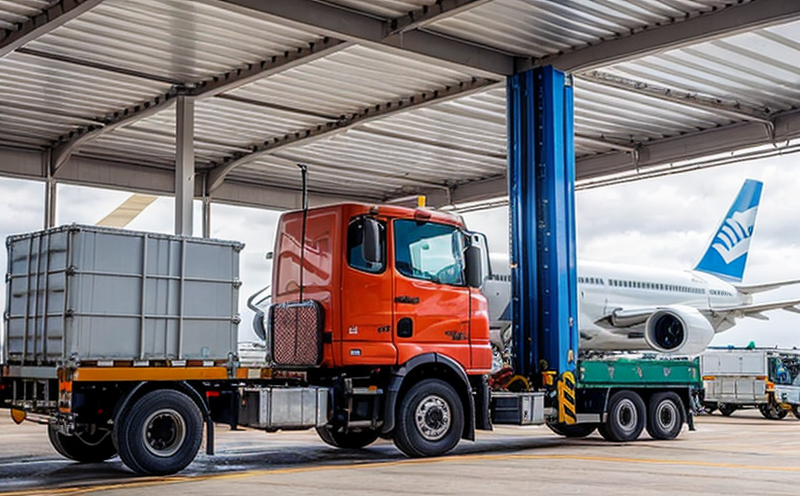Airport cargo handling inspection
The airport cargo handling inspection is a critical component of ensuring safe and efficient operations within the aviation sector. Cargo handling encompasses a wide range of activities including loading, unloading, sorting, and transporting goods through various stages from arrival at an airport to delivery at its final destination. This process involves numerous stakeholders such as airlines, freight forwarders, customs authorities, and ground handlers.
At the heart of this inspection lies the need for precision and reliability in handling cargo that can vary greatly in size, weight, and value. The integrity of the goods must be maintained throughout their journey to avoid delays or damage, which could result in significant financial losses for all parties involved. Furthermore, compliance with international regulations ensures security and reduces the risk of illegal activities such as smuggling.
The inspection process typically begins upon arrival of a cargo aircraft at an airport terminal. Ground handlers are responsible for offloading goods according to specified protocols, often involving heavy machinery like forklifts or cranes. Once unloaded, the cargo is transported to sorting facilities where it undergoes further examination and classification based on destination and type.
One key aspect of this inspection involves verifying that all items comply with airline and regulatory requirements regarding packaging, labeling, and documentation. For instance, perishable goods may require specific temperature controls during transit while hazardous materials must adhere strictly to stringent safety guidelines outlined by organizations like the International Civil Aviation Organization (ICAO).
In addition to physical checks, modern inspection practices also incorporate advanced technologies such as X-ray scanners or gamma ray machines designed to identify potential threats without compromising on accuracy. These tools help detect prohibited items hidden within packages or suspicious containers that might pose risks if left unchecked.
The importance of thorough cargo handling inspections cannot be overstated given the increasing volume and diversity of international trade through airports worldwide. By adhering to best practices in this area, airlines and logistics providers can enhance operational efficiency while minimizing risks associated with non-compliant shipments.
Why It Matters
The significance of airport cargo handling inspections extends beyond mere compliance; it plays a vital role in maintaining the overall security, reliability, and efficiency of global air freight operations. Proper inspection procedures ensure that only legitimate consignments proceed through customs clearance processes, thereby preventing unauthorized goods from entering countries.
Moreover, these inspections contribute significantly towards preserving environmental sustainability by reducing fuel consumption associated with rerouting or returning incorrectly handled cargo back to originating points. Efficient handling also helps minimize delays caused by bureaucratic bottlenecks, thus improving customer satisfaction levels among shippers and receivers alike.
The economic impact of effective cargo inspection cannot be ignored either; it supports the growth of the aviation industry by fostering confidence in air carriers and their partners, which ultimately attracts more investment into infrastructure development projects. Additionally, robust inspection protocols help protect consumer interests by ensuring transparency throughout supply chains.
Applied Standards
Airport cargo handling inspections are guided by several international standards aimed at standardizing practices across different regions and countries. Among them is the International Civil Aviation Organization (ICAO), which sets out general principles for secure air transport operations worldwide. Another crucial document is the IATA Cargo Security Manual, providing detailed guidance on how to implement effective security measures during cargo handling.
For specific testing requirements related to packaging materials or temperature control systems used in cold chain logistics, organizations like ASTM International offer relevant specifications such as D4236 for paperboard and its derivatives used in airfreight containers. Similarly, ISO standards provide guidance on aspects ranging from safety assessments (ISO/TS 15066) to environmental impact evaluations (ISO 14001).
These globally recognized frameworks not only promote consistency but also foster innovation within the industry by encouraging continuous improvement in methodologies and technologies employed. Compliance with these standards reassures stakeholders about the reliability of services provided, enhancing trust between various parties involved in air cargo transportation.
Scope and Methodology
The scope of an airport cargo handling inspection encompasses several key areas that need to be addressed comprehensively during each cycle. Firstly, it includes visual inspections conducted by trained personnel who examine external packaging for signs of damage or tampering. Secondly, weighing checks ensure that the declared weight matches actual measurements taken using calibrated scales.
Thirdly, detailed record keeping is essential to document all aspects of cargo movement from point A to B. This includes maintaining logs of loading and unloading activities alongside photographic evidence where appropriate. Fourthly, compliance verification entails confirming adherence to specific rules set forth by regulatory bodies concerning labeling requirements or documentation formats.
Beyond these fundamental elements, advanced technological solutions play an increasingly important role in enhancing inspection accuracy. For example, automated scanning systems equipped with image recognition algorithms can quickly analyze X-ray images for anomalies indicative of restricted goods or contraband items. Similarly, GPS tracking devices allow real-time monitoring of shipments from the moment they leave the airport until they reach their final destinations.
The methodology adopted depends largely on individual facilities’ resources and capabilities but generally follows a structured approach involving preparation, execution, review, and reporting phases. During preparation, staff receive training updates based on recent changes in applicable laws or industry best practices. Execution involves actual fieldwork carried out by inspectors armed with necessary equipment like handheld devices interfacing directly with database systems.
Review phase focuses on analyzing collected data to identify trends or anomalies warranting further investigation. Finally, reporting ensures dissemination of findings back to relevant stakeholders including clients, regulatory authorities, and internal management teams responsible for decision-making processes related to operational adjustments needed.





